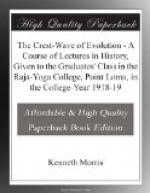“The loss of even the hundredth or the thousandth part of the persons who were then slain, carried away captive, or done to death in Kalinga would now be a matter of deep regret to His Majesty. Although a man should do him any injury, Devanampiya Piadasi holds that it must patiently be borne, so far as it possibly can be borne... for His Majesty desires for all animate beings security, control over the passions, peace of mind, and joyousness. And this is the chief of conquests, in His Majesty’s opinion: the Conquest of Duty.”
Some time later he took the vows of a Buddhist monk, ’entered the Path’; and, as he says, ‘exerted himself strenuously.’
He has been called the ‘Constantine of Buddhism’; there is much talk among the western learned, about his support of that movement having contributed to its decay. They draw analogy from Constantine; even hint that Asoka embraced Buddhism, as the latter did Christianity, from political motives. But the analogy is thoroughlv false. Constantine was a bad man, a very far-gone case; and there was little in the faith he adopted, or favored, as it had come to be at that time, to make him better;—even if he had really believed in it. And it was a defined religio-political body, highly antagonistic to the old state religion of Rome, that he linked his fortunes with. But no sovereign so mighty in compassion is recorded in history as having reigned, as this Asoka. He was the most unsectarian of men. Buddhism as it came to him, and as he left it, was not a sect, but a living spiritual movement. For what is a sect?—Something cut off— from the rest of humanity, and the sources of inner life. But for Asoka, as for the modern Theosophical Movement, there was no religion higher than—Dharma—which word may be translated, ‘the (higher) Law,’ or ‘truth.’ or ‘duty.’ He never ceased to protect the holy men of Brahminism. Edict after edict exhorts his people to honor them. He preached the Good Law; he could not insist too often that different men would have different conceptions as to this Dharma. Each, then, must follow his own conception, and utterly respect his neighbors’. The Good Law, the Doctrine of the Buddhas, was universal; because the objective of all religions was the conquest of the passions and of self. All religions must manifest on this plane as right action and life; and that was the evangel he proclaimed to the world. There was no such sharp antagonism of sects and creeds.
There is speculation as to how he managed, being a world-sovereign —and a highly efficient one—to carry out the vows of a Buddhist monk. As if the begging bowl would have been anything of consequence to such an one! It is a matter of the status of the soul; not of outward paraphernalia. He was a practical man; intensely so; and he showed that a Chakravartin could tread the Path of the Buddhas as well as a wandering monk. One can imagine no Tolstoyan playing at peasant in him. His business in life was momentous. “I am never satisfied with my exertions and my dispatch of business,” he says.




